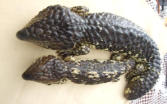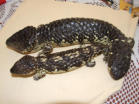

Shingle back






Tiliqua rugosa is a short-tailed, slow moving species of blue-
tongued skink found in Australia.
Three of the four recognized subspecies are found only in
Western Australia, where they are known collectively by the
common name bobtail. The name shingleback is also used,
especially for T. rugosa asper, the only subspecies native to
eastern Australia. T. rugosa has a heavily armoured body
and can be found in various colours, ranging from dark
brown to cream.
It has a short, wide, stumpy tail that resembles its head and
may confuse predators. The tail also contains fat reserves,
which are drawn upon during hibernation in winter.
This skink is an omnivore; it eats snails and plants and
spends much of its time browsing through vegetation for
food. It is often seen sunning on roadsides or other paved
areas.Apart from bobtail and shingleback, a variety of other
common names are used, including stump-tailed skink,
bogeye, pinecone lizard and sleepy lizard.
T. rugosa has a heavily armoured body and can be found in
various colours, ranging from dark brown to cream.Its total
length seldom exceeds 25 inches, but it is a very heavy-bodied
lizard for its length.It has a triangular head and a bright blue
tongue. Its short, stumpy tail is similar in shape to its head.
This possibly evolved as a defence mechanism against
predators, and has led to the common name of "two-headed
skink".[4] Its short tail also contains fat reserves, which the
lizard lives upon during hibernation in winter. Unlike many
skinks, shinglebacks do not exhibit autotomy and cannot
shed their tails


Shingle back






Tiliqua rugosa is a short-
tailed, slow moving species
of blue-tongued skink found
in Australia.
Three of the four recognized
subspecies are found only in
Western Australia, where
they are known collectively
by the common name
bobtail. The name
shingleback is also used,
especially for T. rugosa
asper, the only subspecies
native to eastern Australia.
T. rugosa has a heavily
armoured body and can be
found in various colours,
ranging from dark brown to
cream.
It has a short, wide, stumpy
tail that resembles its head
and may confuse predators.
The tail also contains fat
reserves, which are drawn
upon during hibernation in
winter.
This skink is an omnivore; it
eats snails and plants and
spends much of its time
browsing through vegetation
for food. It is often seen
sunning on roadsides or
other paved areas.Apart
from bobtail and
shingleback, a variety of
other common names are
used, including stump-tailed
skink, bogeye, pinecone
lizard and sleepy lizard.
T. rugosa has a heavily
armoured body and can be
found in various colours,
ranging from dark brown to
cream.Its total length
seldom exceeds 25 inches,
but it is a very heavy-bodied
lizard for its length.It has a
triangular head and a bright
blue tongue. Its short,
stumpy tail is similar in
shape to its head.
This possibly evolved as a
defence mechanism against
predators, and has led to
the common name of "two-
headed skink".[4] Its short
tail also contains fat
reserves, which the lizard
lives upon during
hibernation in winter.
Unlike many skinks,











































































